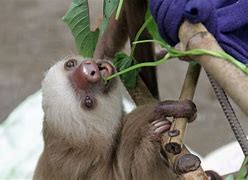Sloth Adalh 1 Juta

Challenges and threats
Both sloth bears and sloths have their own unique set of challenges in the wild. Sloth bears, for example, face deforestation and habitat loss. Forests are cleared for agriculture and urban settlements, resulting in sloth bears losing their home and food sources. Poachers are also an issue since sloth bears’ claws and gallbladders are sold illegally in the wildlife trade business since they are highly valued for medicine and ornamental purposes.
Sloths, both two-fingered and three-fingered, face similar challenges. In the tropical rainforests of Central and South America, rainforests are cut down for logging and converted into farmland and pastures; sloths lose both their homes and food supplies.
Both sloth bears and sloths are grappling with the impacts of human activities that threaten their survival. While each species faces unique challenges based on where and how they live, there is a common thread: most of the hurdles they encounter in the wild can be traced back to human actions.
Meme Coin dan Fenomena Solana
Memecoin di jaringan Solana semakin populer, dan Slothana menjadi salah satu yang paling menonjol.
Investor tertarik pada memecoin, terutama menjelang 19 April, ketika Bitcoin akan mengalami peristiwa halving yang diperkirakan akan mengurangi pasokan dan mungkin meningkatkan harga.
Slothana menawarkan kesempatan unik bagi investor untuk terlibat dalam proyek yang potensial sebelum peristiwa halving Bitcoin. Ini menambah daya tarik Slothana sebagai investasi yang menjanjikan di mata para pelaku pasar crypto.
Baca juga: Dogwifhat (WIF) Menempati Posisi ke-3 dalam Peringkat Meme Coin Berdasarkan Market Cap!
What is a sloth bear?
A Sloth bear is a type of bear species native to India, Sri Lanka, Nepal, and Bhutan. Known for its long snout and long lower lip used for sucking up insects, it’s officially named Melursus ursinus. Despite the name referring to them as ‘lazy’, sloth bears are anything but lazy!
These bears have a distinctive shaggy black coat with a whitish-yellow ‘U’ or ‘Y’ shaped mark on their chest. And although they share a resemblance, sloth bears should not be confused with the Asian Black Bear (Ursus thibetanus)
Slothana: Memecoin Baru di Jaringan Solana
Slothana, dengan simbol $SLOTH, telah menunjukkan potensi yang signifikan dengan berhasil mengumpulkan $1,5 juta hanya dalam beberapa hari melalui presale.
Baca juga: Poopcoin ($POOP) Meluncur di Base, Volume Perdagangan Capai $60 Juta dalam 10 Jam!
Cara unik mereka, yaitu dengan meminta pengguna mengirim token Solana ke alamat tertentu sebagai tukarannya dengan $SLOTH, menarik banyak investor.
Saat ini, Slothana diperdagangkan dengan harga $0,018599 per token, dan diperkirakan akan terus meningkat seiring berlangsungnya presale.
Banyak yang percaya bahwa tim di balik Slothana juga merupakan otak di balik Smog (SMOG), yang mengalami peningkatan harga signifikan setelah diluncurkan.
Jakarta, Pintu News – Dunia crypto kembali dihebohkan dengan kemunculan Slothana, memecoin terbaru yang berjalan di jaringan Solana.
Dalam waktu singkat, Slothana berhasil mengumpulkan dana presale sebesar $1,5 juta, menarik perhatian investor yang berharap proyek ini akan mengikuti jejak sukses memecoin sebelumnya seperti Slerf dan DogWifHat.
What do sloth bears eat?
Despite being in the order Carnivora, sloth bears are myrmecophagous, meaning they consume termites and ants. Occasionally, during monsoon season, they are known to dine on fruit in trees such as mango, fig, ebony, etc., as well as flowers. Termites, ants, beetles, and other insects are also of interest to sloth bears year-round, and they are 95% of their diet.
Aside from digging out mounds, they are capable climbers and can climb trees to knock down honeycombs to collect the honey from the ground.
Scientists study sloth bears around India through GPS collars that communicate through satellites and allow them to collect data from the exact location of the animals at any given time. Scientists have studied and collected data on sloth bear attacks, threats to sloth bears, sloth bear denning, relocation of sloth bears, and sloth bear densities. The sloth bear is the least studied and understood bear in the Indian subcontinent.
Here at SloCo, we similarly study sloths through VHF/GPS collars, backpacks, and data loggers. VHF and GPS collars allow scientists to locate sloths and collect information about the sloth and its habitat.
The overall goal of scientists studying sloths is the same for sloth bears: to ensure long-term survival, conservation, and coexistence.
What can we do to protect both species?
These extraordinary creatures’ continued existence hinges significantly on our actions today. This involves adopting more sustainable farming practices and endorsing conservation initiatives that safeguard the natural habitats of these animals from further degradation.
You can support organizations working with this species, like Wildlife SOS, founded in 1995; it has a strong track record in India for rescuing wildlife in distress, including sloth bears, elephants, leopards, and others. Free the Bears is an organization that works to rescue and rehabilitate bears in various Asian countries.
Four species of ground sloths inhabited the United States at the end of the last Ice Age. These were Jefferson's ground sloth (Megalonyx jeffersonii), Laurillard's ground sloth (Eremotherium laurillardi), the Shasta ground sloth (Nothrotheriops shastensis), and Harlan's ground sloth (Glossotherium harlani). Of these four only two, Jefferson's and Harlan's ground sloths, are found in the midwestern U.S.
Ground sloths were large relatives of the modern two-toed sloths (Choloepus spp.) and three-toed sloths (Bradypus spp.). Unlike modern sloths, which spend most of their time in trees, the ground sloths spent all of their time on the ground. This is fortunate because Jefferson's and Harlan's ground sloth were each about the size of an oxen.
All four species of ground sloth had very large claws. However, all were herbivores. They had relatively small, blunt teeth, which they probably used for browsing on trees and shrubs. The shape of their hip bones indicates that they could stand up on their hind legs. This would allow them to reach high up into trees for the best leaves and twigs.
The picture above shows a reconstruction of Jefferson's ground sloth from the University of Iowa Museum of Natural History.
Are sloth bears related to sloths?
Contrary to their name, sloth bears and sloths are not closely related, and both belong to entirely different taxonomic orders and families with unique evolutionary histories. For example, sloth bears belong to the order Carnivora, which includes mammals such as dogs, cats, seals, and bears. Within this order, they are also under Ursidae or Bear family.
The name “sloth bear” comes from the bear’s slow-moving behavior and long claws, like a sloth, which led early zoologists and taxonomists to draw parallels between them. However, this similarity is due to convergent evolution, where unrelated species independently develop similar traits in response to similar environments.
Despite these surface resemblances, sloth bears and sloths are genetically and taxonomically distant as well as having strikingly different evolutionary paths.
Sloths, unlike sloth bears, belong to the order Pilosa, sharing it with anteaters and armadillos. Over millions of years, sloths have adapted to a slow-paced arboreal lifestyle, developing features like long arms, curved claws, and a slow metabolism to thrive in treetop habitats where they perform various activities, including eating, sleeping, mating, and giving birth.
Where do Sloth Bears Live?
Sloth Bears thrive in the Indian subcontinent’s diverse environments like dry forests, grasslands, wet forests, and mountains. They favor rocky outcrops and caves for daytime shelter. The tropical climate in these regions is marked by high temperatures and substantial rainfall, fostering a biodiverse environment.
Sloths, on the other hand, are found in the rainforests of Central and South America. Preferring a life high up in the trees where they hang using their strong claws. Sloths consider the forest canopy their primary home. They flourish in humid environments and rely on a diverse array of leaves as their main source of food.
Surprisingly, both sloth bears and sloths typically lead solitary lives. Sloth bears may be spotted in groups during times of abundant resources, and occasionally, groups of female sloths share the same tree.
Sloth bones and claws
All four species of ground sloth had very large claws and small, blunt teeth. They all were herbivores and probably used the teeth for browsing on trees and shrubs. The shape of their hip bones indicates that they could stand up on their hind legs. This would allow them to reach high up into trees for the best leaves and twigs.
The bone on the left is the finger bone (phalanx) that supports the claw on the thumb of a Jefferson's ground sloth. The specimen on the right is a tooth, also from a Jefferson's ground sloth.
Both of these specimens were recovered from Heinze Cave, Jefferson County, Missouri. Radiocarbon dating indicates that both specimens are more than 40,000 years old.
All four species of ground sloth became extinct in North America approximately 10,000 years ago. The reason for their extinction is being studied by paleontologists.



